Boxelder Trees: Types, Leaves, Bark, Fruit (With Pictures) – Identification Guide
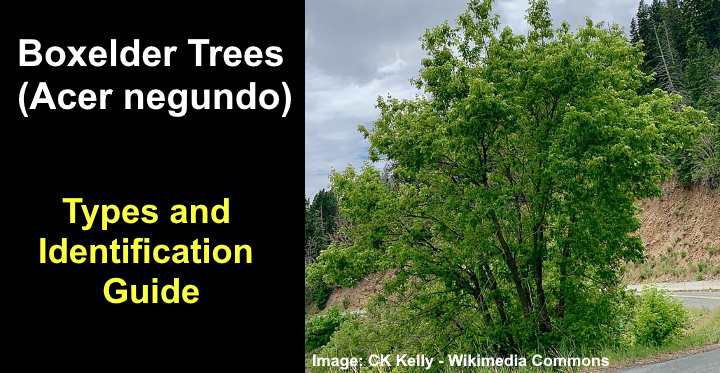
Boxelder is a deciduous, broadleaved, medium-sized tree with a broad, irregular crown and rounded shape. Its identifying features are bright green lance-shaped ovate leaves with serrated margins, winged seeds called samaras, and dark brown ridged bark. Unlike other trees in the genus Acer, boxelder leaves are pinnately compound, with three to seven leaflets on a petiole.
Unfortunately, boxelder trees have a poor reputation due to their brittle wood, messiness, susceptibility to boxelder bugs, and vigorously sending up suckers. However, boxelder trees have tremendous value to a landscape because they are fast-growing, have a broad crown, and thrive in wet, poor soils.
This article is an identification guide of the features of several boxelder tree species. Descriptions and pictures of boxelder leaves, seeds, bark, and growth will help you recognize this native tree in parks, woodlands, or other areas.
About Boxelder Tree (Acer negundo)

Boxelder tree is a deciduous multi-trunked tree which is cold hardy and tolerates poor wet soil
The boxelder (also written box elder) is a fast-growing, short-lived deciduous tree native to North America. The tree is a species of maple tree in the genus Acer and soapberry family Sapindaceae. Due to their fast growth and suckering nature, boxelders are sometimes considered invasive or weedy.
Boxelder trees grow between 35 and 80 ft. (10 – 25 m) tall. A characteristic of boxelder trees is their multiple trunks that can form dense thickets like huge shrubs. Therefore, regular pruning is necessary to remove suckers. The trunks typically measure 1 to 1.6 (0.3 – 0.5 m) in diameter. However, they sometimes measure over 3 ft. (1 m).
Boxelders thrive in USDA zones 2 to 10, meaning they are incredibly cold-hardy. However, they are also tolerant of drought and withstand the hot sun. The medium-sized boxelder thrives in full sun or part shade and performs well in most soils. Although it’s drought-tolerant, the hardy tree can withstand some flooding.
Boxelder trees are classified as dioecious—meaning individual trees can be male or female. The male boxelder trees have more ornamental value because they don’t produce fruit (seeds) and are less messy.
Other names for boxelder trees include ash-leaf maple, box elder maple, and Manitoba maple tree.
Being a member of the maple family, boxelder trees also produce a sweet, sticky sap you can make into a syrup called mountain molasses. However, the tree is mainly grown commercially for pulp as the wood is brittle and weak.
Boxelder Tree Leaves
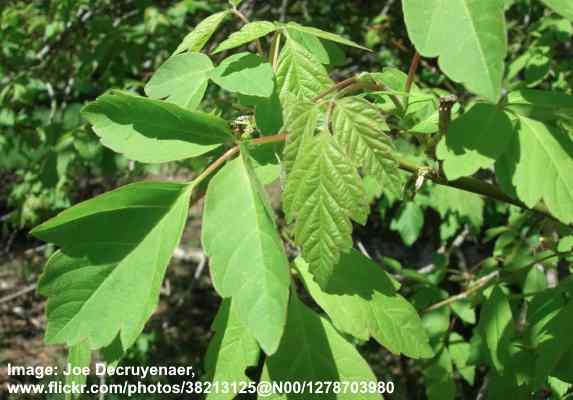
The pinnately compound boxelder leaves have serrated margins
Leaves growing on the boxelder tree are pinnately compound leaves which differentiates them from other maple trees. The bright green ovate leaves measure 2” to 4” (5 – 10 cm) long and have lobed, serrated margins. Typically, three to seven leaflets grow on a petiole.
Boxelder tree leaves are deciduous, light to bright green. They emerge in mid-April to late May and provide a dense canopy. In the fall, the tree’s foliage turns an unimpressive dull yellow. Therefore, the tree’s fall colors are not showy and don’t have much ornamental value.
Boxelder Tree Flowers
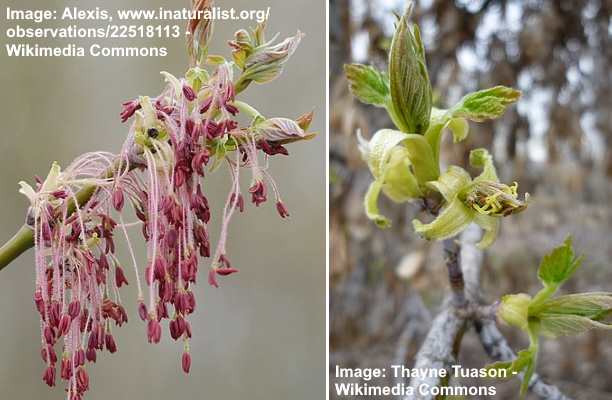
Boxelder flowers: Male (left) and female (right)
Flowers on the boxelder tree are greenish-white or yellowish and appear in early spring, just before the leaves. The tiny insignificant flowers grow in small, drooping clusters called corymbs. Flowers from male boxelder trees are more attractive and have a yellow-green color, and bear tan or reddish pollen-bearing stamens.
Boxelders are dioecious trees, and male and female flowers don’t grow on the same tree. This is another unique feature of these maples as typical maple trees are monoecious. The drooping racemes or corymbs measure 4” to 8” (10 – 20 cm) long.
Boxelder Tree Seeds
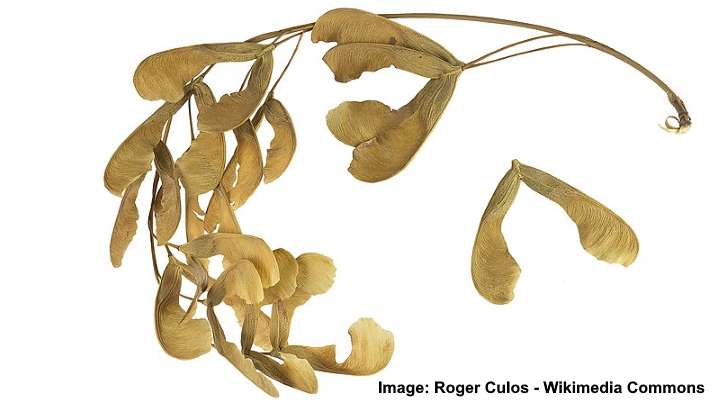
Boxelder seeds are called samaras and grow in pairs
Seeds on the boxelder tree appear after flowering and ripen in August and September. The boxelder seeds are pale yellow winged nutlets called samaras, growing in pairs in drooping clusters. The dangling clusters often persist on the tree into winter when they turn reddish-brown.
Individual samaras are 1” to 1.5” (2.5 – 3.8 cm) long. The boxelder seeds are encased in a papery casing hanging in V-shaped pairs. Seeds drop from boxelder trees and can be messy. Additionally, numerous boxelder seedlings sprout in spring, causing extra work to remove the vigorously growing trees.
The maple seed pods are sometimes referred to as helicopters or whirligigs. This name is due to the spinning action of the “helicopter seeds” as they gently fall to the ground in the wind. These helicopter-like seeds are characteristic of box elders and other maple trees in the genus Acer.
Boxelder Tree Fruit
Also called fruit, boxelder seeds are edible nuts in papery casings. To reveal the boxelder fruit, removing the seed’s outer covering is necessary. It is said that maple tree fruit or nuts are tastiest when they are young and green before they ripen and become brown.
Boxelder Tree Bark
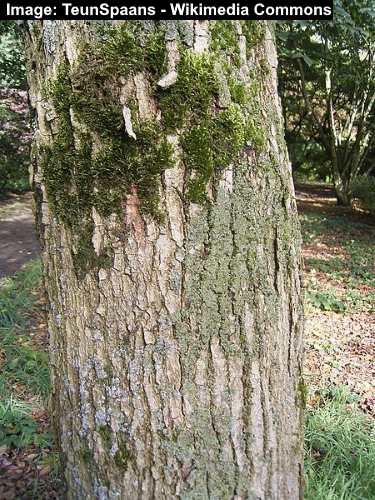
Boxelder bark becomes ridged and scaly as the tree matures
Bark growing on boxelder trees is typically pale gray or light brown. As the tree matures, the bark becomes rough and scaly with deep clefts and interlocking ridges and becomes darker in color.
New shoots on boxelder trees emerge green and develop a waxy violet or pink coating. Stems tend to remain green and don’t form bark. The boxelder tree’s fast growth means that its branches are somewhat brittle and break easily under the weight of snow or in heavy winds.
Boxelder Tree Wood
Wood from a boxelder tree is weak and brittle and doesn’t have great durability. In addition, the boxelder tree’s fast growth means it can’t produce robust timber. Therefore, boxelder wood doesn’t have much commercial value, and the tree is mainly used as pulp in the paper industry.
Boxelder Tree Identification
The identifying features of a boxelder tree are its thick, multi-stemmed growth, irregular canopy, and dense foliage. In addition, this medium-sized tree has bright green, lance-shaped ovate leaves, papery winged samaras that flutter from the tree like helicopters, and small yellow-green flowers that bloom in the spring.
The Drawbacks of Boxelder Trees
Boxelder trees suffer from brittle, weak wood that doesn’t stand up to strong winds and heavy snow. In addition to this, the tree’s leaves and seeds drop over an extended period, meaning there is a constant clear-up in the fall. Also, its vigorous growth means persistent problems with boxelder saplings springing up near the tree.
Another issue with growing boxelder trees is that they are susceptible to pests, especially the boxelder bug. The black and red destructive pests lay eggs in the crevices of the tree’s bark. Although they don’t cause too much tree damage, large numbers of these pesky creatures can get into homes and become a nuisance.
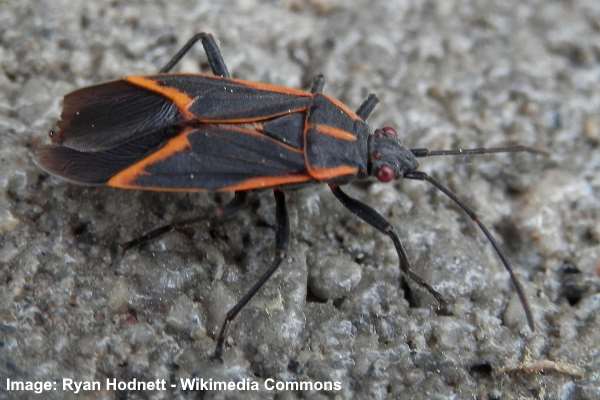
Boxelder bug (Boisea trivittata)
The Benefits of Planting Boxelder Trees
Despite its drawbacks, boxelder trees have several endearing qualities. For example, its fast growth and tolerance of poor soil make the tree useful in many landscapes. In addition, the tree has an important use for wildlife, attracting boxelder beetles, pollinators, and moths.
Due to its robust root system and tolerance to damp, soggy soil, the boxelder tree is ideal for erosion control along the banks of rivers, streams, and lakes.
Types of Boxelder Trees (With Pictures) – Identification Guide
Boxelder trees are native to North America and grow throughout the United States. There are several kinds of boxelder trees, each with identifying characteristics and features. Please read on to learn more about recognizing a boxelder tree in the landscape.
‘Auratum’ Boxelder Tree (Acer negundo ‘Auratum’)
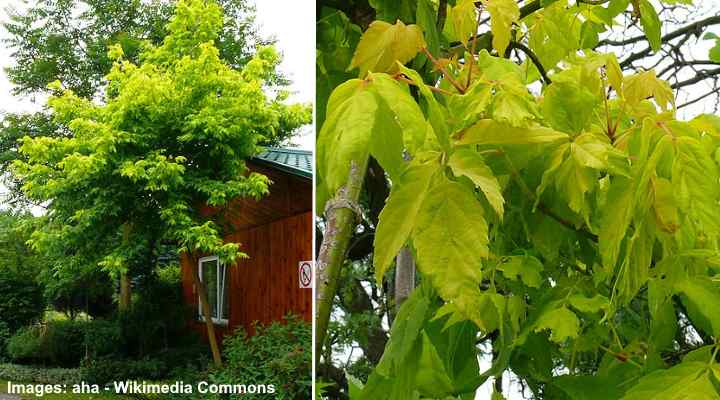
‘Auratum’ boxelder tree has yellowish-green leaves
The ‘Auratum’ boxelder maple tree is a small multi-stemmed shrub-like tree with yellow-green leaves and smooth undersides. The golden yellow leaves grow on reddish stalks, providing visual interest in the summer. Its attractive, spreading crown and deep rooting system make this boxelder species an excellent landscape tree in parklands.
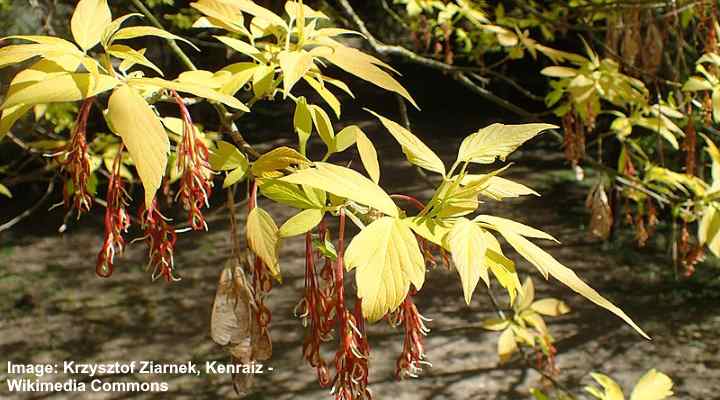
Acer negundo ‘Auratum’ leaves and flowers
‘Auratum’ boxelder has an average growth rate and it matures at 16 to 22 ft. (5 – 7 m) high. Its identifying feature is its yellowish lanceolate leaves with small lobes on the leaf’s apex end, drooping reddish flowers, red stems, and an open, egg-shaped crown.
Also called the ‘Auratum’ ash-leaved maple, the shrub-like tree forms multiple trunks. Its inconspicuous clusters of pendulous flowers bloom in April. After flowering, the ‘Auratum’ boxelder tree produces multitudes of winged seeds that get blown away in strong winds.
‘Aureomarginatum’ Boxelder Tree (Acer negundo ‘Aureomarginatum’)
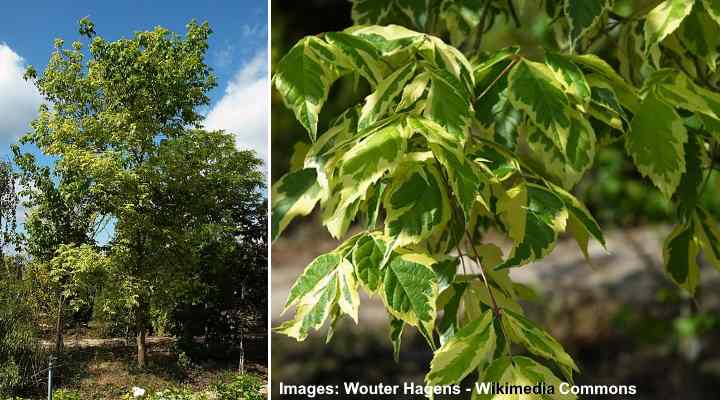
‘Aureovariegatum boxelder tree is identified by its green leaves with yellowish margins
The ‘Aureomarginatum’ boxelder tree is a variegated maple species with bright green leaves and creamy yellow margins. The fast-growing deciduous boxelder cultivar is unique among the species due to its yellow and green leaves. As a result, the tree’s leaves can sometimes appear entirely creamy-yellow with only small patches of green.
The variegated ‘Aureomarginatum’ boxelder is a small multi-trunked tree suitable for residential gardens. The maple tree typically grows 20 to 32 ft. (6 – 10 m), and its rounded crown provides shade. With some pruning when the tree is young, you can train the shrub-like tree to grow as an attractive single-stem landscape tree.
Like all boxelder trees, the distinguishing feature of the ‘Aureomarginatum’ cultivar is its leaf color. The green leaves with their creamy-yellow margins provide visual appeal when planted next to dark-leaved trees.
Thanks to the boxelder ‘Aureomarginatum’ attractive foliage, relatively short height, and oval shape, it can be an excellent choice as a specimen, accent, or shade tree.
‘Flamingo’ Boxelder Tree (Acer negundo ‘Flamingo’)
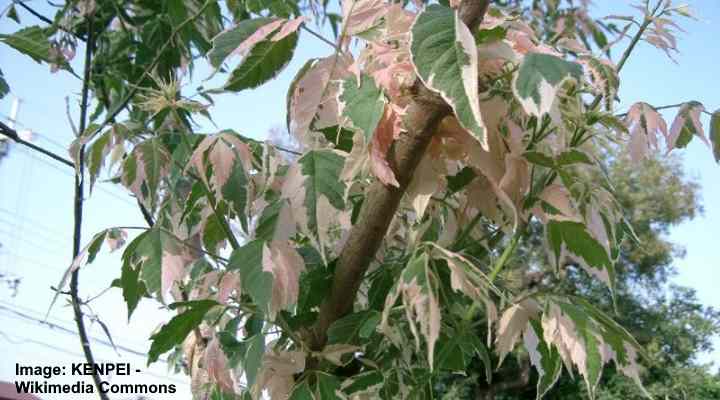
‘Flamingo’ boxelder tree has variegated green and creamy-white leaves with hints of pale pink
The boxelder ‘Flamingo’ cultivar is a spectacular landscaping maple tree due to its eye-catching variegated cream and green leaves with hints of pink blushing. The beautifully colored boxelder leaves emerge pink and mature to green and white before turning yellow in the fall. ‘Flamingo’ boxelder grows 30 to 50 ft. (10 to 15 m) tall.
Like many varieties of boxelder trees, new stems emerge reddish before turning green. The pink and green leaves are compound, growing in groups of three to seven. Additionally, yellowish-green inconspicuous flower clusters appear in spring before the female tree develops helicopter-like winged samaras.
Thanks to its colorful leaves and low maintenance, this small to medium-sized maple species is ideal in a garden landscape. The striking pink and cream leaves that turn pink and green provide visual interest in spring and summer. Then golden yellow colors adorn the tree’s canopy in the fall.
‘Variegatum’ Boxelder Tree (Acer negundo ‘Variegatum’)
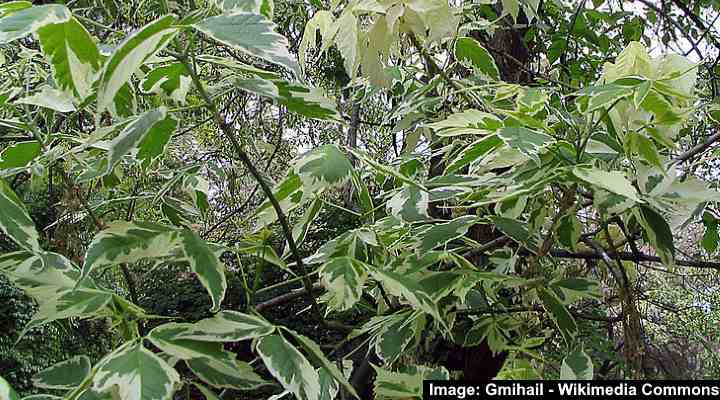
‘Variegatum’ boxelder tree has green and creamy-white variegated leaves
The ‘boxelder ‘Variegatum’ cultivar is a large multi-stemmed deciduous tree with eye-catching creamy-white and green leaves. The compound leaves have three to seven variegated leaflets giving the foliage an overall bright appearance. Dangling clusters of V-shaped samaras cover the tree in late summer and fall.
The ‘Variegatum’ boxelder tree grows 40 to 50 ft. (12 – 15 m) tall and up to 35 ft. (10 m) wide. Its attractive foliage and open, spreading, rounded canopy give this boxelder ornamental value in a landscape. The ‘Variegatum’ boxelder is a good landscaping choice thanks to its low maintenance and minimal pruning requirements.
As with all boxelder species, the ‘Variegatum’ cultivar has a few undesirable traits. First, its branches are relatively weak and brittle, and the tree has a short life. In addition, the tree may attract boxelder bugs to your garden, causing pest problems in the fall when they come indoors.
‘Aureovariegatum’ Boxelder Tree (Acer negundo ‘Aureovariegatum’)
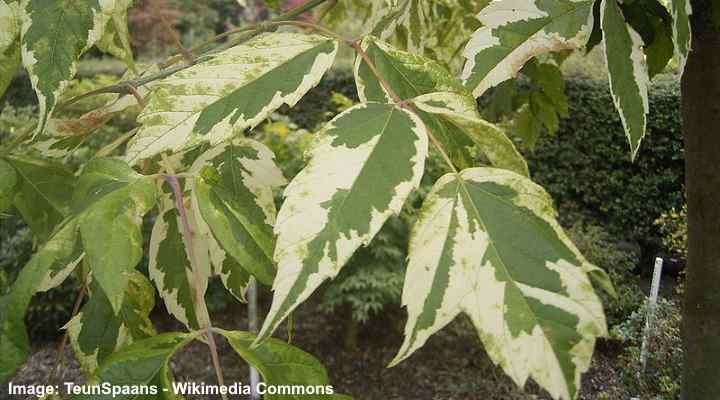
‘Aureovariegatum’ boxelder tree has variegated green and creamy pale yellowish leaves
The boxelder ‘Aureovariegatum’ cultivar is a tall deciduous tree with creamy yellow and green variegated pointed leaves and greenish-red flowers. Like all boxelder species, the ‘Aureovariegatum’ tree has lanceolate leaves with shallow lobes. The striking green and creamy yellow leaves grow in groups of five or seven leaflets on reddish stems.
‘Aureovariegatum’ boxelder trees grow 32 to 82 ft. (10 to 25 m) high and have an irregular oval crown of light green foliage. Although the fast-growing shade tree has some unwelcome characteristics, it grows almost anywhere and is highly adaptable. It is also drought-tolerant when established.
The ornamental value of ‘Aureovariegatum’ boxelder to a landscape is its light green lance-shaped leaves with golden yellow patches.
The medium-sized tree is suitable for growing in USDA zones 5 through 9. It’s also tolerant of urban conditions, pollution, and drought.
‘Winter Lightning’ Boxelder Tree (Acer negundo ‘Winter Lightning’)
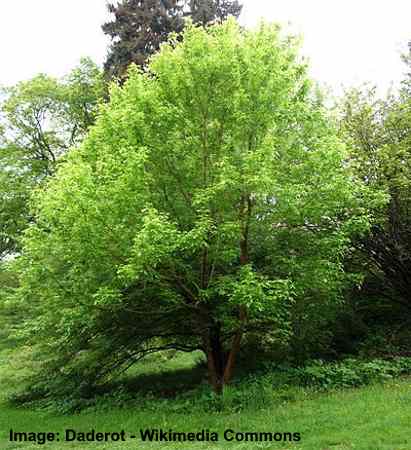
‘Winter Lightning’ boxelder tree has yellow twigs during fall and winter
Also called yellow-twigged boxelder, the ‘Winter Lightning’ cultivar is a sizable shrub-like tree with dark green lobed leaves, creamy-yellow or pale green flowers, and a spreading canopy. The outstanding feature of this boxelder is its showy yellow twigs that appear in the fall and winter.
Boxelder ‘Winter Lightning’ grows 20 to 30 ft. (6 – 12 m) tall and up to 25 ft. (7.6 m) wide. The tree’s foliage is green from spring until late summer when the leaves turn a dull yellow in the fall. The ‘Winter Landscape’ boxelder adds plenty of color to a barren landscape due to its ornamental stems.
Like all boxelder tree species, the ‘Winter Lightning’ cultivar has compound leaves with three to nine leaflets growing on yellow petioles.
How to Prune Boxelder Trees
Boxelder trees require regular pruning to prevent the sizable shrub-like tree from growing into a dense thicket. This is because the weak branches droop as the tree matures. Therefore, it’s necessary to remove drooping branches to retain space under the tree’s canopy. Also, because the branches are particularly brittle, they are prone to damage after strong winds, ice storms, or heavy snowfall.
Boxelder seedlings are also something to look out for. Seeds from the maple trees fall in significant numbers in late winter and spring and quickly germinate and sprout. Therefore, it’s not uncommon for many seedlings to grow in the proximity of boxelder maple trees. So, you should remove those to prevent a small woodland from growing in your backyard.
Related articles:
- Maple Trees – Identification Guide
- Small Ornamental Trees for Flower Beds
- Small Flowering Trees for your Garden
